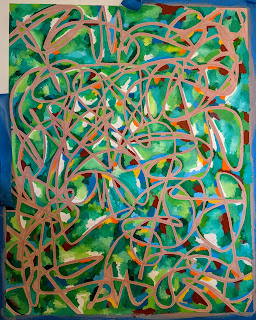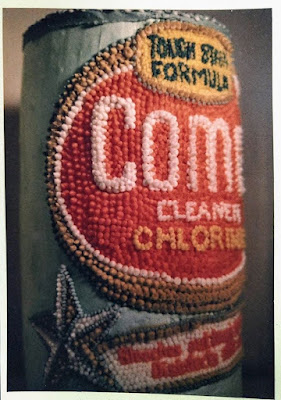Monday, March 28, 2022
Sunday, March 27, 2022
Saturday, March 26, 2022
ERIC KANDEL, This is your brain on art: A neuroscientist's lessons on why abstract art makes our brains hurt so good | Salon.com
MISC. # Hastags....
Wednesday, March 23, 2022
Artspace Asks: "Who Governs?"
Artists frame history as a living thing, and the show is better for it. Across from Mitchell’s introductory text, Richey has created an archive around The A-Mazing Bureaucratic Birthday Cake, a June 1988 art installation designed and consumed for the city’s 350th birthday celebrations on the New Haven Green. At the time, Richey was a member of the then-fledgling Arts Council of Greater New Haven and a working artist herself. Biagio DiLieto was serving what would be his last term as mayor. Festival coordinator and artist Robert Gregson commissioned Richey for the piece.
To complete the project, she worked with a team of 50 artists-turned-“cake commissioners,” as well as members of the Arts Council of Greater New Haven, the New Haven Register, and Leon Weinberg of the now-defunct Leon’s Bakery to build a large, scalable iced replica of City Hall and provide enough sheet cake to feed 3,500 city residents. True to the installation’s name—and its attempt to mirror city policy—residents had to make it through a maze to receive a piece of cake, for which they received a permit for consumption. Even the building and its iced replica resonated: Henry Austin built New Haven’s gingerbread house of a City Hall in 1861, exactly 100 years before Who Governs? was published and 127 years before the city's birthday.
Amidst parades, horse-drawn carriage rides, live music and dancing on the Green in 1988, cake commissioners and celebrity guests doled out sweet slices with permits to consume cake. They used rubber stamps for fork usage and appropriate cake zoning. Richey’s aim was not just celebratory: she also intended to remind DiLieto and the city’s Board of Alders (then dubbed the Board of Aldermen) that there was an acute need for affordable artists' housing across the city. It’s a need that still exists—and is perhaps exacerbated by New Haven’s number of luxury apartments—today.
In the gallery, Richey has assembled a small display that walks viewers through the installation, with photographs, preserved rubber stamps, old programs and a screen-printed shirt from the event. It’s a window into history that is both cheeky and instructive: the things Richey was asking for in 1988 are still things artists are asking for today. The only difference is that New Haven is 32 years and four mayoral administrations older than it was then.
When a viewer sees a faded yellow “permit to eat cake,” they may be reminded of the long, confusion-riddled showdown between artists and alders over who got to live in the Hamilton Street Clock Factory last year. Or, perhaps, the narrow-eyed befuddlement that often strikes first-time presenters to the city’s Historic District Commission, when a ten-minute request is met with four hours of debate. Or the Board of Alders' struggle to balance the city budget each year when 60 percent of the city’s grand list is tax exempt.
"The bureaucracy involved frightens, inspires and fascinates me," Richey told the New Haven Register in June 1988. "But through it all I've discovered that systems, hierarchy, aren't necessarily bad, that in certain cases they are essential to get things done. It's been quite a stretch for me working with so many individuals and groups."
FHP: 2NU4U2C* Artist Bio
ARTIST BIO: 2020 BEV RICHEY
Born in New Haven, CT, Bev Richey was exposed early in life to the separation of head and heart and raised in an intellectual community while living in a spiritually intuitive Jewish home.
This early dichotomy continues to inform her art practice.
As an artist, arts organizer, and arts administrator she encouraged and supported artists and non-artists alike to work together on ephemeral public artworks. This work reached a pinnacle with a commission by the city of New Haven that incorporated over a hundred active participants from diverse backgrounds working together to develop and deliver over 3500 pieces of birthday cake free to the New Haven community.
Having accomplished numerous artistic goals related to community and inclusivity, Richey was then ready to move on. Her experience growing up in a deeply divided community created an interest in exploring issues related to private versus public. This made the midwest fertile ground for her interests. Settling on a ridge in the driftless region of Wisconsin, Richey was inspired and informed by the natural world as well as the nearby small communities.
A move to Milwaukee a decade later brought the opportunity for her to re-engage in urban culture. She was able to advance her interest in advanced Art History studies at UWM and in 2013 joined the Midwest Jewish Artists Laboratory. The Midwest Jewish Artists’ Laboratory was founded and directed by Jody Hirsh, Jewish Education Director funded by the Covenant Foundation. The MJAL became central in Richey’s art life. She credits the focus of a yearly theme of study, monthly study sessions with an annual exhibition requirement, combined with developing relationships with other Jewish artists, as a critical factor in her current studio practice. After six years of active LAB participation, Richey remains committed.
Richey has an undergraduate degree in psychology followed by university studio art classes, an artist apprenticeship, and advanced studies in Art History. In her early years working as an arts administrator, she co-founded and co-directed several artists’ organizations while serving on local nonprofit arts boards.
Tuesday, March 22, 2022
1980'S NEW HAVEN ARTISTS UNITED-ONLINE ARCHIVE | ***FYI: I worked on this post as a way to prepare for the exhibit at the New Haven Museum | Facebook
Monday, March 21, 2022
Mixed Use - Daily Nutmeg FACTORY
ABBC SEARCH RESULTS: myMESSeMUSEum: Search results for ABBC
Friday, March 18, 2022
Thursday, March 17, 2022
Waterboarding: Last Gasp for Habeas Corpus and the Geneva Conventions - YouTube JSG Jonathan Shorr Gallery September 30, 2006
Waterboarding: Last Gasp for Habeas Corpus and the Geneva Conventions - YouTube
 |
| Digital Projections by Beverly Richey 2006 |
Link to DPDuckworth Blog Post: https://dpduckworth.com/tag/ezra-talmatch/
Work on this post: Bradley Manning | dpduckworth blog post, photos of projections tow youtubes
BEVERLY RICHEY'S "HAMDENOTABLE" ARCHIVE/PORTFOLIO: MOVING MEDIA DIGITAL PROJECTIONS
Detainee1- "Detainee" , The Lab, Monday, January 29 through Friday, February 2, 2007. "Detainee"
Art Explores Politics in a Dehumanizing Environment Created with Paint and Digital Projections.
Detainee links the image of the United States of America with its recent decision to implement the Military Commissions Act of 2006, focusing within this performance work on the absolute power that the State has determined is within its moral and political prerogative to hold over any individual. David Duckworth, as a bound blindfolded detainee, becomes the paintbrush with which interrogators paint the American Flag on the floor of the gallery. Digital projections by Beverly Richey, painted walls by Max Yawney, and sound compositions by Patrick Todd, augment this central action by creating an environment in which detached governmental roles in a dehumanizing process is explored.
The Roger Smith Hotel is committed to relaying all types of performance and fine art to the public through its gallery and all of its wall space. With the combination of The Lab's prime location in midtown (Manhattan) and the intensity of Detainee, it is sure to attract the attention of the public. It is both courageous and bold to become involved with such an influential piece of art during such an uncertain time.
Roger Smith



























